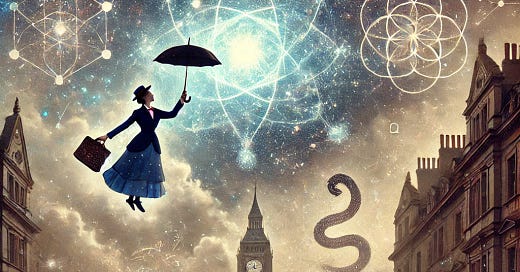There's a strange flickering at the edges of awareness that happens when the universe decides to play connect-the-dots with your deepest obsessions. I've seen it happen in the quantum laboratories at Synergyworks, witnessed it during Dr. Nelson's random number generator experiments, but rarely have I observed such a perfect synchronicity as the one that recently unfolded for a friend of mine in the maternal matrix of Mary Poppins.
Picture this: A woman who, as a child, bypassed the plastic perfection of Barbie and the warrior princess theatrics of She-Ra, fixating instead on the supernatural nanny with an umbrella and a carpet bag containing what might as well have been the stuff of creation itself. Not to mention her cosmic twin, Maria, another Julie Andrews incarnation who transformed Austrian mountains into living soundscapes through sheer force of will and perfect pitch.
This wasn't mere childhood fancy. It was an unconscious recognition of the divine feminine at work – a precocious intuition that these singing, dancing embodiments of otherworldly order-bringing were tapping into something primordial. Something that resonated with the syllable "MA" – that ancient phonemic code for mother that transcends language barriers and epochs.
Fast forward to present day. Our protagonist, still carrying this Mary-fixation in her psychic DNA, discovers through a friend's Facebook post that the original P.L. Travers text contained elements that Disney, in its infinite corporate wisdom, decided were perhaps too metaphysically spicy for mid-century American audiences.
Mary Poppins, it seems, had a cousin – a wise serpent who dropped this little bombshell of cosmic unity:
"We are all made of the same stuff, remember, we of the Jungle, you of the City. The same substance composes us — the tree overhead, the stone beneath us, the bird, the beast, the star — we are all one, all moving to the same end."
If you're thinking this sounds suspiciously like quantum entanglement explained through Victorian English prose, you're catching on. The serpent continues:
"Remember that when you no longer remember me, my child ... bird and beast and stone and star — we are all one, all one—child and serpent, star and stone — all one."
I've heard Bretminster Fullofit expound similar concepts after particularly intense sessions with his hyperstitious linguistic programming team, but rarely with such elegant simplicity.
Our Mary-devotee's mind was already expanding faster than a universe with an inflation problem when she encountered another revelation: P.L. Travers herself had admitted that Mary Poppins wasn't invented but "entirely spontaneous" – a character who "represented the Mother Goddess" in a tale that was essentially "a Zen story."
But the rabbit hole wasn't finished with her yet.
The final synchronicity arrived like a memetic sledgehammer – the discovery that the original books featured a character named MAIA (specifically spelled out by the character herself as M-A-I-A), who was a star based on the eldest of the Pleiades sisters.
Now, this is where reality starts to get slippery. Our protagonist had been developing technology also called MAIA – an acronym inspired by the mother archetype. She hadn't known about the Poppins connection when naming her tech.
Coincidence? Perhaps. But as the Synergyworks team demonstrates daily, coincidence might just be what happens when the universe decides to wink at you.
Was this a Mandela Effect scenario? Had this information always existed, quietly waiting for the right moment to manifest in our protagonist's awareness? Or had she somehow influenced reality through her own obsession with the maternal syllable "MA," creating a backcasting effect that rippled through the morphogenetic field?
The penguins, sadly, were unavailable for comment.
What's clear is that these cultural archetypes – Mary Poppins, Maria von Trapp – serve as conduits for something ancient and powerful. The divine mother doesn't need designer handbags or Instagram filters. She arrives with an umbrella, challenges rigid authority, repurposes curtains into children's clothes, and communes with animated beings that elude the perceptions of the overly rational.
In the words of my friend and occasional consciousness co-explorer at Fullofit Industries, Drendan Blackson: "Reality isn't just stranger than we imagine – it's stranger than we can imagine, until we start imagining it differently."
So the next time a nanny descends from the clouds or a governess teaches Austrian children to sing their way through Nazi occupation, pay attention. It might just be the universe – or the divine mother herself – tapping you on the shoulder, ready to lead you into a chalk drawing or up a mountain where the metaphysical air is clear enough to see beyond the veil of ordinary reality.
Just don't be surprised if, when you look deeper, you find she's been there all along, hidden in plain sight – in the stories we tell our children, in the cultural icons we create, and perhaps most importantly, in that ancient syllable that formed some of our first words as humans: MA.
This is SynTony Robbins, signing off from the intersection of weird consciousness and Disney classics, wondering if I should check what's really in this blue thermos Drendan handed me this morning...





